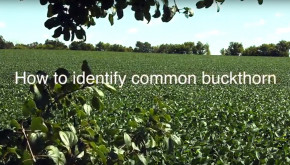
Buckthorn is the poster child for invasive species in the upper Midwest. When I say that I teach about invasive species, folks inevitably ask me, “Like buckthorn?” or share their stories of working hard, year after year, to manage this common understory menace. At our recent Extension holiday party, little wood circles of buckthorn cookies were passed out as rewards! The wood was harvested by a Minnesota Master Naturalist from one of our great State Parks. My point is that in a weird way, buckthorn unites us in forestry. Now it’s crossing over to agriculture and connecting us to the Minnesota Soybean Growers Association. (Didn’t see that coming, did you?!)
Here’s how: Common buckthorn, Rhamnus cathartica, is the required overwintering host of the invasive soybean aphid, a major, and expensive, pest on soybeans. Traditionally, farmers have tackled soybean aphid with insecticide applications, including aerial sprays. A few years ago, the Minnesota Soybean Growers Association approached researchers in the University of Minnesota Department of Forestry wondering if we could research the connections between buckthorn and soybean aphids. It turns out there’s very little research on that relationship. Unanswered questions included: Do soybean aphids overwinter on dead buckthorn (which could happen if buckthorn was managed with a basal bark treatment)? Does distance between buckthorn (and forest edge) and the soybean fields matter? If you cut buckthorn, say, 10 feet from the field edge, is that enough? We realized the need to answer an even more basic question: Is there any evidence that buckthorn density impacts soybean aphid populations? Out of these unanswered questions, a research project sprouted. Project outreach included two videos: buckthorn identification and introduction to buckthorn management, both geared at soybean farmers and produced by the University of Minnesota Extension Forestry.
In the 2017 growing season, forestry on farm research produced some amazing results! First, the density of buckthorn in some of our woodlands is truly (depressingly?) amazing, ranging from 0 to 7,863 buckthorn stems/acre! Next, preliminary observations yielded a positive correlation between buckthorn density and soybean aphid population density, indicating that when there’s more buckthorn, there’s more soybean aphid. Soybean aphid populations were generally lower last year, so our sampling numbers were rarely above the economic threshold, a number some farmers use to trigger soybean aphid management. Economic threshold is a little complicated and we’re not going into the details now, but for any farmers reading this, we don’t yet know if buckthorn management impacts economic threshold for soybean aphids. Thankfully, we are funded to continue this research during the 2018 growing season.
OK, now you know what buckthorn and soybean have in common: soybean aphids. I’ll quickly introduce our new buckthorn identification video. Minnesota Extension produced two videos for this project, and because there was concern that farmers were a new audience for us in forestry, we worked hard to create these videos using the best research on videos for education and action. We also connected with farmers via a small focus group. Final products: content expert (me!) explaining buckthorn identification for farmers and an introduction to buckthorn management told from farmers’ perspectives (more on that next week).
So with that, please check out our new buckthorn identification video! Buckthorn ID
For more information, and to read our new factsheet, visit our website: http://www.myminnesotawoods.umn.edu/buckthorn-soybean-aphids

